2020 GMC Sierra Review & Buying Guide | The same but different
https://ift.tt/37TYua1
For the most part, the 2020 GMC Sierra 1500 and the Chevy Silverado are very close siblings. And with the more modestly equipped Sierra SLE and SLT models, choosing between the equivalent Chevy and GMC largely comes down to styling preference and whether you got a better deal at the GMC dealer. They’re almost identical twins.
Almost. Because despite the shared DNA, there are differences in terms of model choice. There’s no GMC equivalent to the cheaper Custom Trail Boss, for instance, but there is the high-dollar off-road-oriented AT4 that goes beyond the Chevy LT Trail Boss with more equipment and the availability of GMC’s unique MultiPro tailgate and CarbonPro carbon fiber bed. Those are also available on the GMC Sierra Denali, which further differs with an adaptive suspension not offered by Chevrolet that seriously improves the ride comfort and handling composure of GM’s full-size trucks.
GMC therefore makes a compelling case for itself if you’re willing to spend more for your truck, but having said that, the range-topping Sierras also don’t go above-and-beyond in the same ways as the ritzy Ram 1500 and Ford F-150 trim levels do to provide a proper luxury truck experience. The new Duramax diesel engine at least stands out, but otherwise the Sierra doesn’t offer a lot that others can’t match or better (even within the GM family).
What’s new for 2020?
CarbonPro Editions debut for the AT4 and Denali trim levels. These include the CarbonPro composite bed and a Kicker audio system in the MultiPro tailgate. The AT4 versions also gets some unique exterior trim.
Mechanically, a 10-speed automatic is now paired with the drivetrain combo of 5.3-liter V8, Dynamic Fuel Management and four-wheel drive. Aiding visibility are newly available trailer tow mirrors, a bed-view camera, and a high-def 360-degree camera system with trailering elements.
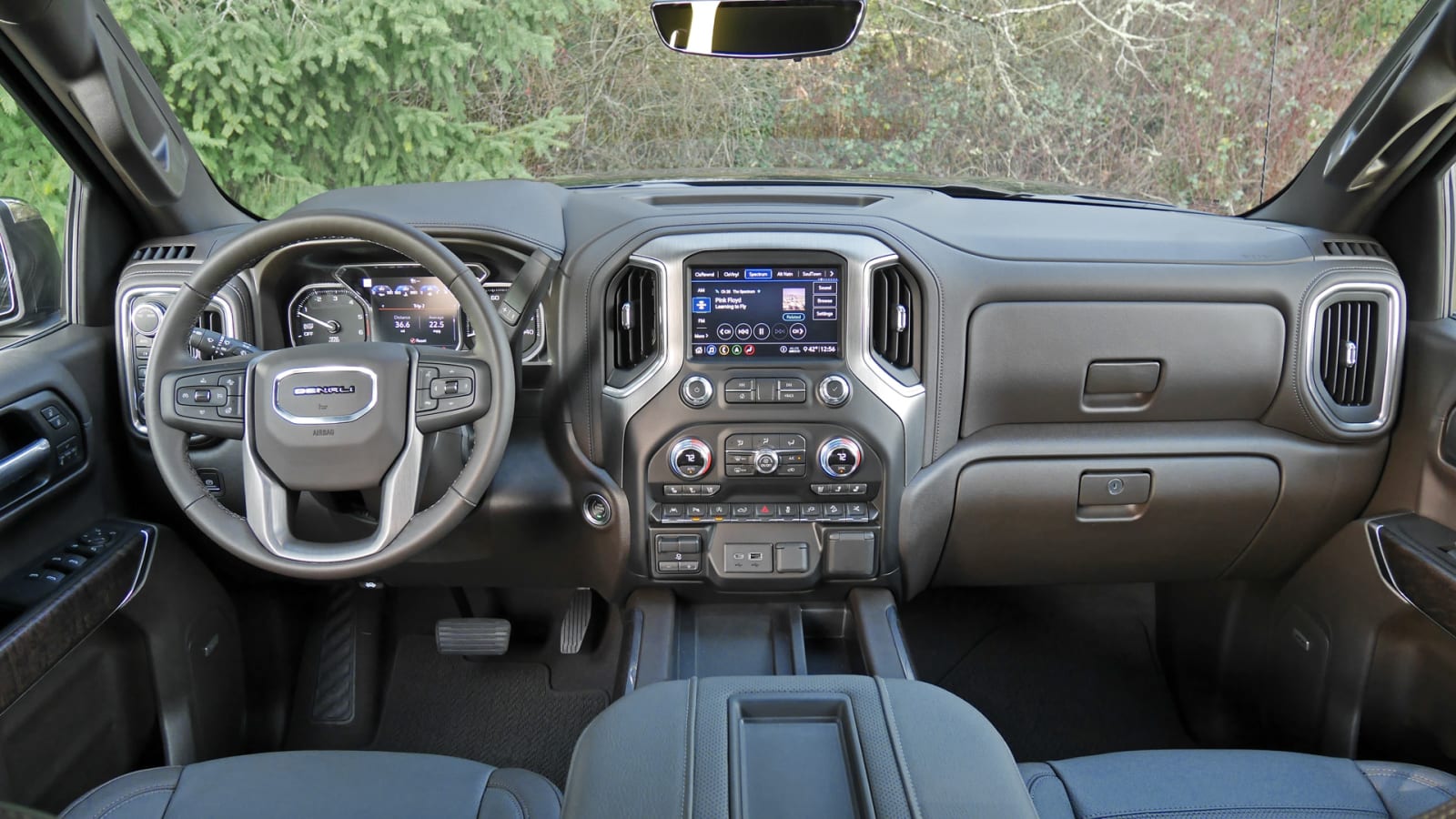
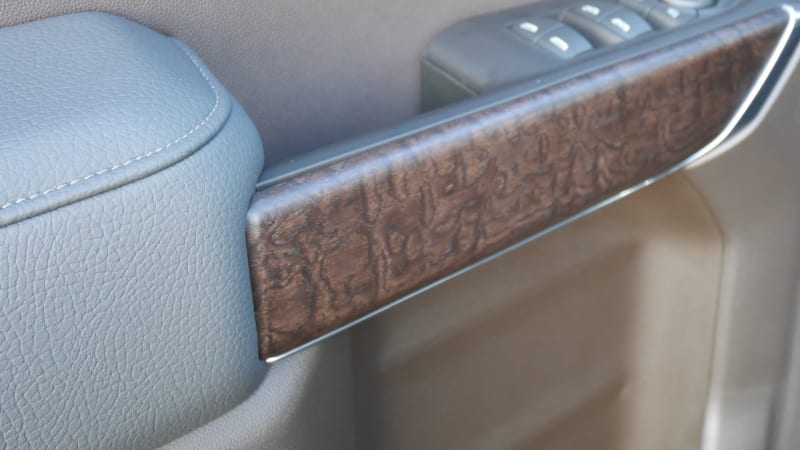
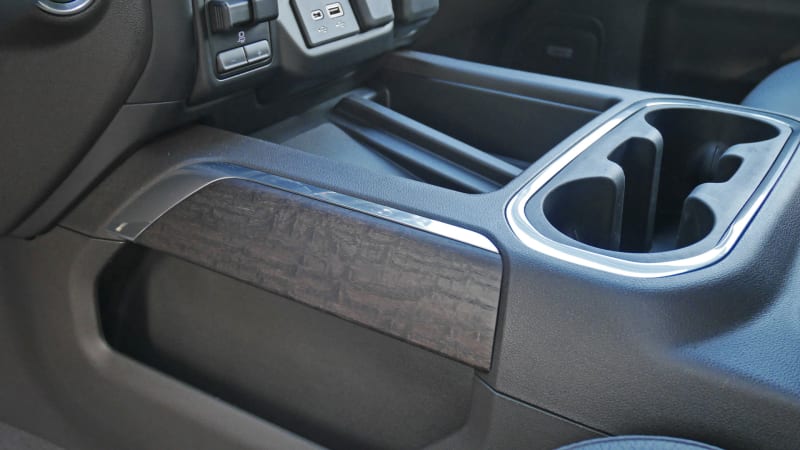
What’s the interior and in-car technology like?
Like its Silverado sibling, the Sierra’s cabin is its least compelling and competitive attribute, falling far behind the Ram 1500 and Ford F-150 in terms of quality and design. The dash is drab and frankly ugly in every trim level, but the cabin is particularly damning in the Sierra Denali. Its black vinyl “stitched” onto the black dash and some token strips of wood trim slapped onto the center console and doors just aren’t enough to create the sort of high-dollar ambience truck buyers can find elsewhere. That might’ve been sufficient when the Denali was the only luxury truck, but not anymore.
At least the technology offerings are generous. All trim levels come standard with a touchscreen (8-inches on all but the base model), Apple CarPlay, Android Auto and a six-speaker sound system (two speakers with a regular cab), while the popular SLE adds OnStar and in-truck 4G LTE WiFi. Upper trim levels can add extra USB ports, various trailering apps and aids, multiple camera systems for parking and trailering, wireless smartphone charging and audio upgrades.
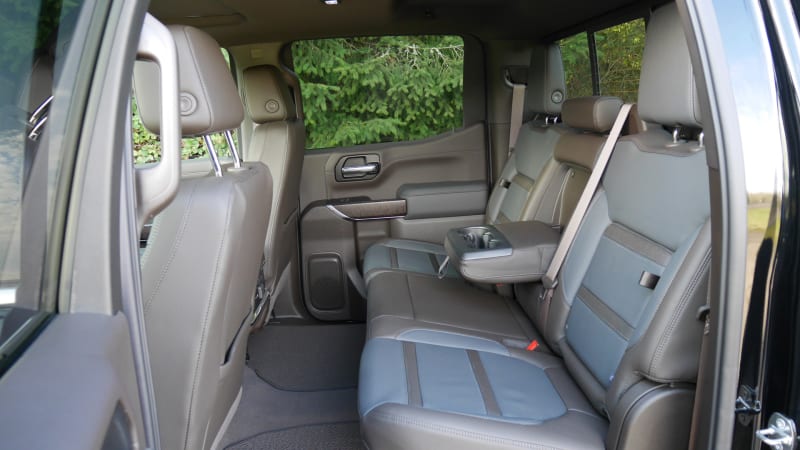

How big is it?
The Sierra 1500 Crew Cab, pictured above left, offers limo-like sprawl-out space in its back seat aided by a colossal rear door. As expected, the Double Cab’s rear seatback is more upright and less comfortable (pictured above, right). Legroom may be class-leading, but it’s still tight behind a tall driver, meaning the Double Cab’s back seat is ultimately best suited for occasional use, or children. At least its front-hinged rear doors are a better setup than the F-150 Super Cab’s annoying clamshells. As usual, you can get a three-person 40/20/40 split bench up front (all trims but AT4 and Denali) or bucket seats with a full center console (not available base or SLE).
What about the bed? The thinner, taller walls introduced last year have resulted in a bed that ultimately holds more than anything else in the segment. Better still, maximum payload ranges from 1,680 to 2,240 pounds, which is generally a few hundred pounds more than an F-150 or Ram 1500. Yet, there is more to consider with the Sierra’s bed than just its volume and payload. For starters, it offers the MultiPro tailgate, which provides myriad configurations but chiefly provides a quick way to climb into the bed. You can even outfit it with a dedicated Kicker sound system, shown in the below gallery. But wait, there’s more! The Sierra Denali and Sierra AT4 can be equipped with the CarbonPro carbon fiber composite bed that GMC says provides added “strength, durability and scratch resistance” to go with a potential 59-pound weight reduction depending on configuration. Basically, it’s a bed and liner in one.
What’s the performance and fuel economy?
Standard only on the base trim is a 4.3-liter V6 that produces 285 horsepower and 305 pound-feet of torque. It comes standard with a six-speed automatic and Active Fuel Management (AFM) that shuts down half the cylinders to save fuel. All trims get 17 mpg in combined driving with this engine.
Standard on the SLE and Elevation (and optional only on the base truck) is a 2.7-liter turbocharged four-cylinder that produces 310 hp and 348 lb-ft of torque. It has an eight-speed automatic and also gets AFM (yes, it can run on two cylinders). It achieves between 19 and 21 mpg combined, which may seem like a minor advantage, but in terms of actual gas money spent, it could save as much as $400 per year over the V6. It’s also the best fuel economy of any non-diesel full-size truck.
Standard on the SLT, AT4 and Denali is a 5.3-liter V8 that produces 355 hp and 383 lb-ft of torque. It’s optional on SLE and Elevation. With its six-speed automatic and AFM it returns 17 mpg combined. However, certain trim levels can outfit this engine with an eight-speed automatic and the more advanced Dynamic Fuel Management (DFM) that raises fuel economy to a V6-beating 18 (4WD) or 19 (2WD) mpg combined. For 2020, however, you can also pair it in certain trims with a 10-speed automatic that can, depending on configuration, improve efficiency by as much as 1 mpg combined.
Optional on the SLT, AT4 and Denali is a 6.2-liter V8 that displaces 6.2 liters and produces 420 hp and 460 lb-ft of torque. It only gets the 10-speed and DFM, and returns 17 mpg combined.
Optional on all but the base trim is a 3.0-liter turbodiesel inline-six that produces 277 hp and 460 lb-ft of torque. It too gets the 10-speed automatic. It returns 26 mpg combined with 2WD, and 24 with 4WD. That matches the Ram 1500 EcoDiesel and is 2 mpg combined better than the F-150 Power Stroke.
What’s it like to drive?
Like every American full-size truck, the Sierra and Silverado’s driving experience depends greatly on the engine you choose – and as GM offers more engines than anyone else, the spread of difference is even greater. We have yet to try the base V6, but we found the turbocharged four-cylinder to be as beefy and efficient as advertised, easily assuaging concerns that you can’t put a four-cylinder in a full-size truck. Still, we think that it represents questionable value relative Ford’s small turbo V6 and Ram’s mild-hybrid V8. A better power/fuel economy proposition is the new Duramax diesel engine – its torque matches the big 6.2-liter V8, its fuel economy will be vastly superior and it’s shockingly quiet. It’s definitely worth strong consideration.
But we’re guessing most Sierra buyers will be looking at a V8. In that case, we’ve found that 6.2-liter is obviously stronger than the 5.3-liter truck, but you also don’t strictly need it. We’ve towed hefty loads with both, and the 6.2-liter is more an example of overkill than necessity.
To this point, however, everything we’ve written also applies to the Silverado. The Sierra’s breadth of driving experiences is actually even greater due to the Denali trim’s adaptive dampers that provide superior ride and body control to the standard suspension. We’ve noted in separate Silverado/Sierra trucks have a tendency when driving over imperfect pavement for either punishing harshness (big wheels) or unusually nautical bounding (small wheels). Neither occurs with the more civilized, big-wheeled Denali. If you’re looking for a reason to choose Sierra over Silverado (and have the money for a big-dollar truck), this is it.
What more can I read about the GMC Sierra 1500?
We test the off-road-oriented Sierra AT4 when equipped with the 6.2-liter V8 and Dynamic Fuel Management.
Our first drive of the Sierra Denali, including more in-depth information about its design and engineering.
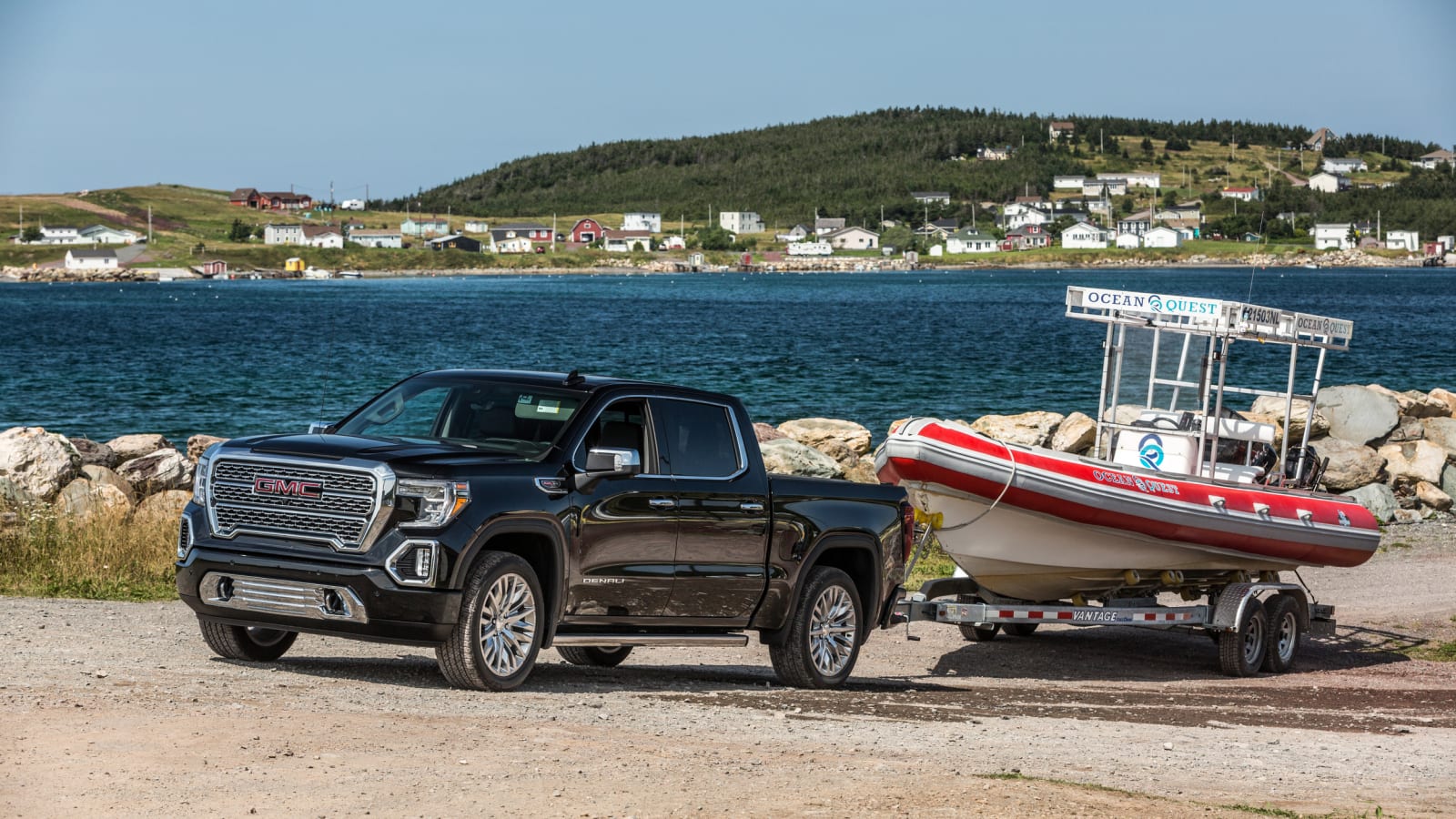
Video: the MultiPro Tailgate explained
Video: GMC MultiPro Tailgate vs the Ram Multifunction Tailgate
What features are available and what’s the price?
The 2020 GMC Sierra 1500 is available in regular cab (base trim only), the extended Double Cab and Crew Cab styles as well as three bed lengths and two front seating options that result in max seating for five or six. Available trim levels are base, SLE, Elevation, SLT, AT4 and Denali (Crew Cab only).
Pricing starts at $31,195, including the $1,595 destination charge, but as that’s for a regular cab base model, it’s almost irrelevant for most truck shoppers. Really, things start off with the SLE Double Cab for $39,395.
A complete breakdown of specs, features and local pricing of each trim level can be found here on Autoblog. However, it should be noted that the AT4 is the off-road-oriented model that we featured here, while the Sierra Denali is the range-topping luxury-oriented model available with every convenience and indulgence feature in GM’s toolbox.
What are its safety equipment and crash ratings?
Forward collision warning, low-speed automatic emergency braking and lane-keeping assist are only available on the SLT, AT4 and Denali trim levels. Blind-spot and rear cross-traffic warning are optional on all trim levels but Denali, where they are standard. A variety of camera systems and other technology features are also available to improve trailering, both in terms of ease of use as well as safety.
The Insurance Institute for Highway Safety gave the Sierra 1500 Crew Cab the highest possible rating of Good in all crash categories but the new small overlap front-passenger test where it got a Marginal (third of four) score. It also got a Poor headlight rating, but a Superior rating for its optional forward collision warning/prevention system.
Auto Blog
via Autoblog https://ift.tt/1afPJWx
January 10, 2020 at 08:24AM